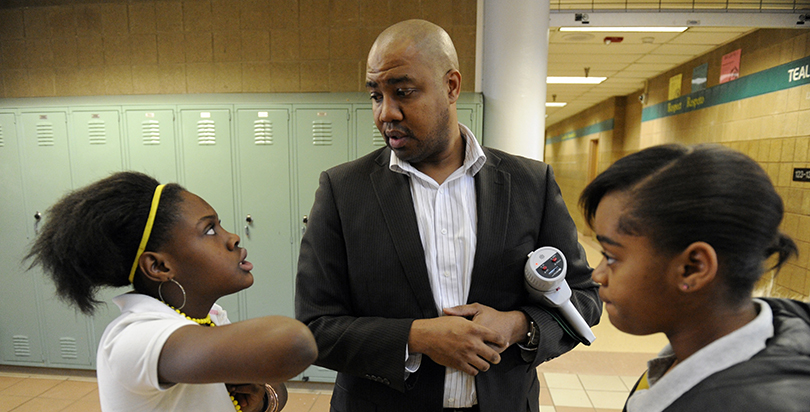How Denver Is Tackling the ‘Invisible Tax’ on Black Educators

When Allen Smith was a senior at George Washington High School in Denver in the 1980s, he participated in a panel discussion about how the urban school system could better serve students of color. Smith said he thought the district could hire more black teachers. He was thinking about people like his football coach, who instilled in him the value of doing his best to help others.
“He really showed me that black men could be in a profession that could make a difference,” Smith said.
Smith would go on to make a difference, too. He started a charter school in Denver that regularly sent at-risk youth to college, then successfully grew a district elementary school. In 2008, Denver Public Schools tapped him to turn around chronically low-performing Martin Luther King Jr. Early College. It became an award-winning school where even his former coach wanted to work.
Close to three decades after Smith graduated from high school, the district is still grappling with a seemingly impenetrable problem: not enough black educators for the number of black students who could benefit from them, and too many who feel they are mistreated because of their race.
“It’s been going on for 20 years. It’s been going on for 40 years,” Smith, now a district administrator, said in an interview with The 74. “Education has been around 200 years; we have seen inequitable practices in education since the beginning.”
Now Denver Public Schools will try a new approach to solve the problem, with Smith in charge.
The district announced Monday that it would start a task force in response to a recently released report that revealed black educators felt excluded and discriminated against because of their race. The effort includes five working groups that will evaluate the district on a host of issues, from how many black students have access to rigorous coursework to what can be done to increase the pool of minority school leaders.
The district hopes the task force steering committee will recommend policy changes to the school board by the end of the school year.
“We will take on this task, and we will take it on headfirst,” Smith said this week at a press conference. “Because we certainly believe that this is work that needs to be done.”
Denver is one of many cities that are striving to recruit and retain a diverse teacher corps to keep pace with an exploding minority student population in public schools.
Even when school districts hire more minority teachers, experts say, they often struggle to create work environments where those educators feel included and not pigeonholed. As U.S. Secretary of Education John King recently put it, school systems still have to figure out how to alleviate the “invisible tax” imposed on minority educators when they are among the only nonwhite teachers in a school.
King defined this “tax” as additional responsibility imposed on teachers of color when they are asked, for example, to serve as school disciplinarians on the assumption that they can better relate to African-American boys with behavior issues; when they are viewed as experts in matters of cultural diversity; or when they must shoulder the burden of coaching students on how to deal with racism on school trips. These added duties, King believes, take an emotional toll that can lead black teachers to burn out and ultimately quit teaching.
“It’s seldom that school districts take a look at why teachers of color leave,” said Jean Madsen, a professor of education at Texas A&M University, who has studied the topic.
Nationally, the share of minority teachers increased to 17 percent in 2012, up from 12 percent in 1987, according to a report from the Albert Shanker Institute, which is affiliated with the American Federation of Teachers. But the share of black teachers, who are more likely to work in high-poverty schools, has declined in nine major cities; they were leaving the field at a faster rate than other groups, the report found.
Denver’s 241 black teachers make up 4 percent of the district’s total workforce, while black students make up 13.8 percent of its student body. Only 3 percent of the district’s applicant pool for teacher positions is black, according to the report. That means the ratio of black students to black teachers was 51 to 1 last year, up from 44 to 1 in 1970. By contrast, Denver’s Latino student-to-teacher ratio declined from 206 to 1 in 1970 to 52 to 1 in 2014, according to Chalkbeat.
Last school year, retention of black educators was comparable to that of other ethnic groups, according to the district. Yet, in an 82-page report released a few months ago, black educators told Sharon Bailey, a former school board member and researcher, that they see huge problems with diversity, including black students being unfairly judged by white teachers and black teachers being stereotyped as angry, undervalued as a professionals and overlooked for promotions.
In fact, 51 of the study’s 70 subjects rated the level of “institutional racism” in the school district at 8 or higher on a scale of 1 to 10, while 17 rated the level of institutional racism at 7 or below. The participants in the study were chosen after they voluntarily responded to an inquiry from the district.
“We have institutional racism. We have bias. This report wasn’t a surprise,” school board president Anne Rowe said a press conference this week. “This is real. It matters.”
Research says that black students often benefit when they are taught by black educators. One study released earlier this year found that after controlling for test scores, black students are less likely to be referred to gifted and talented programs if they have a non-black teacher than if they have a black instructor. Other research shows that black students are less likely to be deemed disruptive when they have a black teacher in front of their classroom, and that when black students are taught by a black teacher, their math and reading test scores improve faster.
In the Denver report, black educators gave examples of how black students were disciplined more harshly than white students for similar infractions. In one example, two teachers told Bailey that when a white male student was tossing chairs in class, he was moved to a higher-level math class because his behavior was a sign that he was “bored.” In contrast, a black male student who “balled his fists in defiance” was suspended.
Echoing King’s findings, several black educators cited in the Denver report said that if they happen to be one of the only black educators working in a school, they are more likely to become the default disciplinarian because they “know how to relate” to black students.
“I’m a special education teacher, and I have kids who aren’t even in special education being sent to me just because they can’t deal with behavior,” said one teacher. “These kids act out, and they just get rid of them. These adults hold onto these grudges and they just don’t let go. So the kids know who they don’t like and who doesn’t like them. …They know who has given up on them.”
But while their race might enable them to connect more easily to kids of color, black educators also said they felt they were more likely to be reprimanded or dismissed because of their race. Black female educators often said they were stereotyped as “angry black women,” which denied them the respect of their colleagues, according to Bailey.
“I don’t know what’s going on, but African-American women are systematically being removed, looked over, passed up and stepped on. Systematically moved out of the field, looked over for promotions and positions and having promotions taken back,” one educator said. “They say we’re actually going to give this job to a young white woman who is out of district. But you can go with her as her support to show her the ropes. And by the way, after you’ve been there a while to show her the ropes, you no longer have a job. Those are the kinds of things that are happening.”
There is little quantitative research into whether black teachers face an extra disciplinary burden or are less likely to be promoted because of their race, but these themes are consistent in several qualitative studies. (One recent study on black workers overall revealed they are more closely scrutinized by employers, which in turn is more likely to lead to worse performance reviews and even job loss.)
That black educators in Denver would say their race helps them serve kids of color better but holds them back professionally was no surprise to Madsen.
In her own research, she found black teachers “ended up being pigeonholed” as the “black expert,” she said. She added that schools sent the message to black teachers that “your place was to work with students of color. Your place was not to add expertise on curriculum or discipline.”
Smith, who previously worked in Oakland, Calif., and Charlotte, N.C., said he has seen similar trends in other school districts around the country, but Denver is approaching the problem with unprecedented vigor.
In addition to heading the task force, Smith has established an advisory team of black educators that will meet with the superintendent every few months to focus on how to measure equity in the district. The school system will also be starting a speaker series featuring minority education leaders from around the country, and it will continue its efforts to increase recruitment and mentoring of minority educators.
“We cannot run away from it,” Smith said. “We cannot hide from it.”
Get stories like these delivered straight to your inbox. Sign up for The 74 Newsletter

;)
